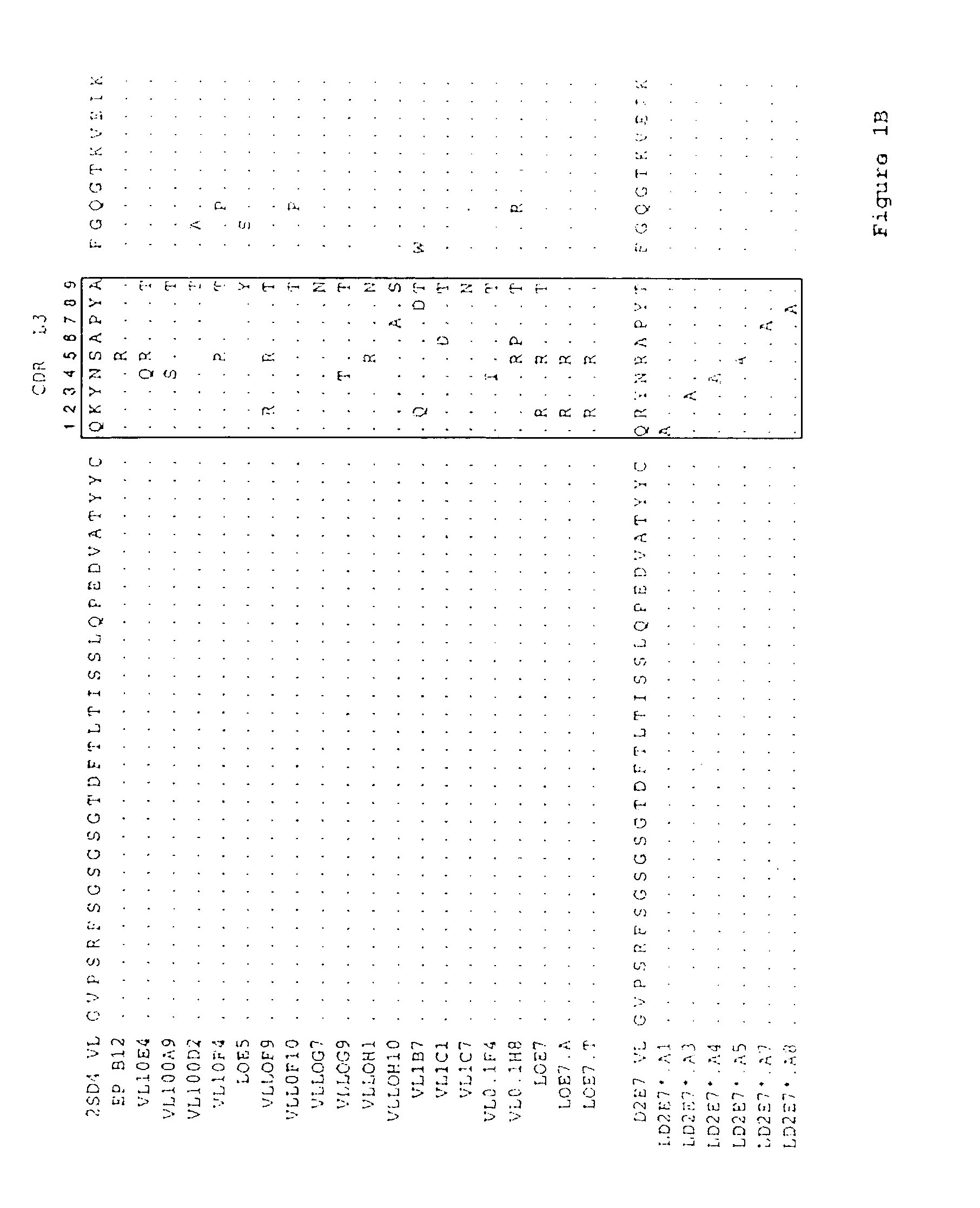Human antibodies that bind human TNFα
- Summary
- Abstract
- Description
- Claims
- Application Information
AI Technical Summary
Benefits of technology
Problems solved by technology
Method used
Image
Examples
example 1
Kinetic Analysis of Binding of Human Antibodies to hTNFα
[0146]Real-time binding interactions between ligand (biotinylated recombinant human TNFα (rhTNFα) immobilized on a biosensor matrix) and analyte (antibodies in solution) were measured by surface plasmon resonance (SPR) using the BIAcore system (Pharmacia Biosensor, Piscataway, N.J.). The system utilizes the optical properties of SPR to detect alterations in protein concentrations within a dextran biosensor matrix. Proteins are covalently bound to the dextran matrix at known concentrations. Antibodies are injected through the dextran matrix and specific binding between injected antibodies and immobilized ligand results in an increased matrix protein concentration and resultant change in the SPR signal. These changes in SPR signal are recorded as resonance units (RU) and are displayed with respect to time along the y-axis of a sensorgram.
[0147]To facilitate immobilization of biotinylated rhTNFα on the biosensor matrix, streptavid...
example 2
Alanine Scanning Mutagenesis of D2E7 CDR3 Domains
[0156]A series of single alanine mutations were introduced by standard methods along the CDR3 domain of the D2E7 VL and the D2E7 VH regions. The light chain mutations are illustrated in FIG. 1B (LD2E7*.A1, LD2E7*.A3, LD2E7*.A4, LD2E7*.A5, LD2E7*.A7 and LD2E7*.A8, having an alanine mutation at position 1, 3, 4, 5, 7 or 8, respectively, of the D2E7 VL CDR3 domain). The heavy chain mutations are illustrated in FIG. 2B (HD2E7*.A1, HD2E7*.A2, HD2E7*.A3, HD2E7*.A4, HD2E7*.A5, HD2E7*.A6, HD2E7*.A7, HD2E7*.A8 and HD2E7*.A9, having an alanine mutation at position 2, 3, 4, 5, 6, 8, 9, 10 or 11, respectively, of the D2E7 VH CDR3 domain). The kinetics of rhTNFα interaction with an antibody composed of wild-type D2E7 VL and VH was compared to that of antibodies composed of 1) a wild-type D2E7 VL paired with an alanine-substituted D2E7 VH; 2) a wild-type D2E7 VH paired with an alanine-substituted D2E7 VL; or 3) an alanine-substituted D2E7 VL paired...
example 3
Binding Analysis of D2E7-Related Antibodies
[0160]A series of antibodies related in sequence to D2E7 were analyzed for their binding to rhTNFα, as compared to D2E7, by surface plasmon resonance as described in Example 1. The amino acid sequences of the VL regions tested are shown in FIGS. 1A and 1B. The amino acid sequences of the VH regions tested are shown in FIGS. 2A and 2B. The Koffrates for various VH / VL pairs (in the indicated format, either as a full-length IgG1 or IgG4 antibody or as a scFv) are summarized below in Table 6:
[0161]
TABLE 6Binding of D2E7-Related Antibodies to Biotinylated rhTNFαVHVLFormatKoff(sec−1)D2E7 VHD2E7 VLIgG1 / IgG49.65 × 10−5VH1-D2LOE7IgG1 / IgG4 7.7 × 10−5VH1-D2LOE7scFv 4.6 × 10−4VH1-D2.NLOE7.TIgG4 2.1 × 10−5VH1-D2.YLOE7.AIgG4 2.7 × 10−5VH1-D2.NLOE7.AIgG4 3.2 × 10−5VH1-D2EP B12scFv 8.0 × 10−4VH1-D22SD4 VLscFv1.94 × 10−33C-H2LOE7scFv 1.5 × 10−32SD4 VHLOE7scFv6.07 × 10−32SD4 VH2SD4 VLscFv1.37 × 10−2VH1A112SD4 VLscFv1.34 × 10−2VH1B122SD4 VLscFv1.01 × 10−2VH1B...
PUM
| Property | Measurement | Unit |
|---|---|---|
| Molar density | aaaaa | aaaaa |
| Frequency | aaaaa | aaaaa |
| Frequency | aaaaa | aaaaa |
Abstract
Description
Claims
Application Information
 Login to View More
Login to View More - R&D
- Intellectual Property
- Life Sciences
- Materials
- Tech Scout
- Unparalleled Data Quality
- Higher Quality Content
- 60% Fewer Hallucinations
Browse by: Latest US Patents, China's latest patents, Technical Efficacy Thesaurus, Application Domain, Technology Topic, Popular Technical Reports.
© 2025 PatSnap. All rights reserved.Legal|Privacy policy|Modern Slavery Act Transparency Statement|Sitemap|About US| Contact US: help@patsnap.com



